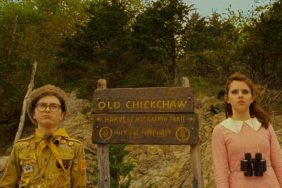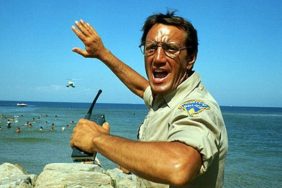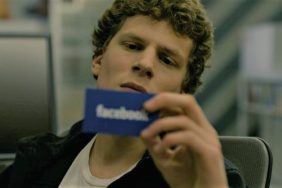Three years and 156 installments later, The Best Movie Ever comes to a close. This ongoing series was designed to cut past the waffling that too often comes with “Top Ten” lists and simply ask film critics – in particular the ones who have been here the whole time: Witney Seibold, Brian Formo and William Bibbiani (that’s me, speaking in third person for dramatic effect) – to pick just one film to represent the best of a genre, or the crowning achievement in a filmmaker or actor’s long and illustrious career.
If you read our extensive backlog, you’ll find a plethora of incredible motion picture recommendations, thoughtful defenses of unusual films, and the occasional headscratcher (Honey, I Blew Up the Kid was an unironic selection once, yes really). We’re all very proud of the column, but the time has come to move on, and so for our very last installment we have asked our critics to each present one film – and just one film – that they think has the very best ending in motion picture history.
It’s not as spoiler-filled a discussion as you might think. And as one last hurrah, we’re giving our critics an opportunity – if they choose to take it – to say goodbye to the column and, in one case, to Crave. Thank you everybody for reading, thank you everybody for writing, and thank you to all the wonderful filmmakers who made this column such a joy to compose every week since 2014!
Brian Formo’s Pick: The 400 Blows (1959)

Criterion
Firstly, I’d say that it’s been a pleasure collaborating with William and Witney for the past three years. Before I get to my pick that’ll close this editorial exercise, lemme gush a little. William was my first editor and he gave me many opportunities. Heck, those opportunities helped me see a few different parts of the world, including my first time to Europe for a press trip, my first time to the Toronto International Film Festival and my first encounters with real, live celebrities. But it’s not just trips and precious few minutes with talented folks that made working with William great. It’s that he was so passionate in film and he could sniff that out in others and let them follow certain scents that spoke to them. I came to Los Angeles from the DIY underground of rock ‘n roll in the Pacific Northwest and William reminded me of the past attributes of DIY: If you’re interested in something and you’ve proven that you’re accountable, we’ll let you plant your passion flag here and give you a fertile ground to grow. Brian, you like James Gray, tell our readers why. Next thing you know, I’m on stage hosting a Q+A for Gray’s new film in Los Angeles.
Throughout these many exciting peeks behind the film journalism curtain that William afforded me something that was very important to me was that it was evident that William is a standup individual who cares about people’s feelings and struggles. I didn’t know it then, because William was my first editor, but I know now that I was very lucky to be ushered into this impersonal film journalism pool by a highly personable and genteel person. Because I’m a softy and because there’s not enough thanks given in this profession, it felt only appropriate to write these words up for an ending post. So thank you William, thank you Witney and thank you Crave for allowing me plant a DIY flag here for a while. Also, William and Witney are two of the most talented film writers I’ve ever read.
As for movie endings, I’ll just say that my favorite movie ending is one that doesn’t tidy things up or answer every question, but instead ushers you out with thoughts about the rest of the film and how it got to where it did. The journey is the destination as the spun Ralph Waldo Emerson quote says and that’s how I feel about film. Films that end in a way that overshadows the bulk of the film are less interesting to me than ones that just feel perfectly timed in closing the narrative. Because my favorite ending is an open ending, I’ll go with one of the earliest and most effective: The 400 Blows.
Modern independent cinema owes a lot to the French New Wave, which itself was like an independent answer to Hollywood, just from a different nation. While Jean-Luc Godard was a playful and verbose auteur, one who inspired many areas of Wes Anderson, Quentin Tarantino and many other American indie darlings, he never knew how to end a movie. It was almost always a gunshot followed by “The End.” A manifestation of the saying, “all you need to make a movie is a girl and a gun.” Godard’s more heartfelt partner in the New Wave, Francois Truffaut, created something far more poetic in The 400 Blows: the freeze frame on a character’s face in a moment of immense reflection on the events we’d just witnessed (here, the events that led to a young boy deciding to run away from home and he ends up at the beach for the first time in his life, feeling that the world is much bigger than he ever imagined; it’s part terrifying, part magic).
Because Truffaut loved his young Antoine Doinel character so much he ended up making more films that answered the question: What happened next? But the remaining Doinel trilogy felt like whimsical wish fulfillment. The 400 Blows is an achingly real portrait of a boy who is uninspired by school and unloved by his parents. The gasp at the size of the ocean is an absolute perfect ending. And it reinforces that the wash-over tidal effect of small things in Doinel’s life that got him to this point is the true journey. The ocean isn’t his destination. It is a place for reflection. Reflection is what the best movie endings provoke.
Witney Seibold’s Pick: Some Like It Hot (1959)

United Artists
A good ending is, of course, just a key element of an overall great film. It’s the ending that can put into context – or in several notable instances, re-contextualize – a film that had been, up to that point, either already great, or at least very good. It is the perfect dessert, glass of Madeira, or sharp cup of espresso to finish a rich, complex meal. The subject of movie endings is discussed frequently, and coming up with the single definitive denouement for all of film history is largely impossible.
Does one reveal the twist ending of Planet of the Apes? The freakout climax of 2001: A Space Odyssey? The gentle unspoken romance of Lost in Translation? The defiant denial of Gone with the Wind? The identity of Rosebud in Citizen Kane? The nihilism of Easy Rider? The meaningless ambiguity of Blade Runner? The interpretation-rich bus ride from The Graduate? The reveal in Psycho? The greatest dialogue ever from Casablanca? American Psycho? Todd Hayne’s Safe? The hug with The Lady in the Radiator from Eraserhead? The final walk in The Discreet Charm of the Bourgeoisie? The final penetrating stare from The 400 Blows? Spin the wheel, take your pick, and you too will be correct. All of these films were on my short list.
I will select – as is my mere preference for the day – one of the more notorious laugh lines from one of the more famous Hollywood films. Billy Wilder’s Some Like It Hot is, as is often touted, one of the best of all film comedies, playing at once as a grim examination of Depression-era life mid-crash (the film is set in 1929), a dissection of gender dynamics, and a hilarious near-Shakespearean farce. Jack Lemmon and Tony Curtis, two impoverished musicians hiding out from the Mob, disguise themselves as women, and join a traveling women’s musical troupe. Curtis uses the opportunity to adopt a Cary Grant-esque male persona to seduce the troupe’s star, played by Marilyn Monroe, while Lemmon finds himself on the receiving end of the intense affection of a rich widower (Joe E. Brown).
I won’t write down the film’s final line here, just in case you haven’t seen it, so I shall describe it thus: Curtis and Lemmon have managed to slip the pursuit of the Mob, and are fleeing in a boat with Monroe and Brown. Curtis admits that he’d been lying about his wealthy alter-ego, and Monroe doesn’t care. Lemmon, then, admits to Brown that he was actually a man this whole time, and not a female musician named Daphne. Brown’s reaction to this news is comedically perfect, of course, but it also reveals a weird open-mindedness for a film that was made by the Hollywood machine in 1959. Indeed, in the modern age, Some Like It Hot plays like a salient treatise on gender fluidity more than it did in 1959, when the notion of “gender fluidity” wasn’t even a notion yet, and sexuality was rarely openly discussed. It’s weirdly daring without losing any humor. It’s pretty damn perfect.
William Bibbiani’s Pick: Citizen Kane (1941)

RKO Radio Pictures
“A fellow will remember a lot of things you wouldn’t think he’d remember,” Mr. Bernstein tells the faceless reporter in Citizen Kane. “You take me. One day, back in 1896, I was crossing over to Jersey on the ferry, and as we pulled out, there was another ferry pulling in, and on it there was a girl waiting to get off. A white dress she had on. She was carrying a white parasol. I only saw her for one second. She didn’t see me at all, but I’ll bet a month hasn’t gone by since that I haven’t thought of that girl.”
Citizen Kane isn’t a film about Mr. Bernstein. It’s a film about a man named Charles Foster Kane, who had everything, lost everything, and performed one incredible act after another in a desperate attempt to be loved. It’s the great American success story about achieving the ultimate capitalistic success and finding, at the end, that you have nothing. And by examining the story of Charles Foster Kane, played by the film’s director/co-writer Orson Welles, we find out what his extraordinary life meant to all the people around him. But what nobody ever figures out is what, exactly, Kane’s life meant to Kane himself.
If you have somehow managed to not find out the ending to Citizen Kane (an impressive feat, given the film’s notoriety), I’ll let you discover it for yourself. And when the moment comes that the film’s story comes crashing together, and you find out what Kane’s last word really means – “Rosebud” – then you might be asking yourself what it all means. Why, exactly, is that one little thing so very important?
And you’ll go back to that speech, I hope, and realize that Orson Welles, his co-writer Herman J. Mankiewicz and the wonderful actor Everett Sloane all laid it out for you. That our lives have a great impact on the people around us but inside, in our own little worlds, it’s the little things that really matter. The roads not traveled, the mistakes we’ve made, the wee bits of memory that drive us forward even though nobody – perhaps, not even ourselves – fully understand them.
The Best Movie Ever comes to a close today, perhaps not forever but certainly for now. I’m grateful that we’ve had an opportunity to recommend some beautiful and wonderful and fascinating works of art for all of our readers to experience. And if any of the movies we’ve recommended have nestled into a little corner of your brain, like that girl with the parasol, then I think all of us here will be able to agree that we’ve done a nice thing, and that this series has had a happy ending after all.
Thank you, everybody, for reading. Onward and upward, to greater glory!







